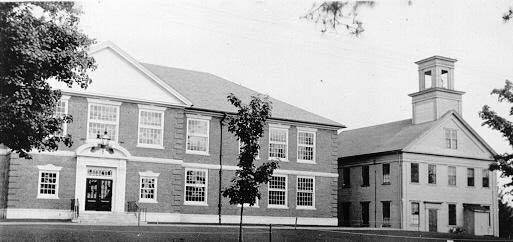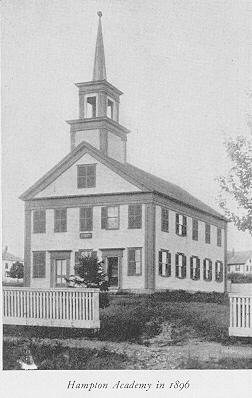Official Souvenir Program Book
January 1 – December 31, 1988

The day the old Academy was torn down, August 1940.
By Bruce E. Russell
{From the 1938 Tercentenary Pictorial Magazine}
The people of Hampton having been convinced by the Reverend Josiah Webster of the need for higher education than that provided by the common schools, petitioned the General Court for incorporation of a Proprietary School, and this petition was granted on June 16th, 1810.
Funds were needed and thirty individuals subscribed shares totaling one thousand dollars. This amount being insufficient, a meeting was held in February 1811, and a committee formed to solicit further funds. Arrangements were finally completed for the erection of a one story school building, to be situated on the Green where the Meeting House formerly stood, the land being accepted as a gift from the town. A second story was added in December 1820 and the school thereafter was called an Academy.
In the summer of 1821, it was decided to turn over the property to a permanent board of trustees to administer and the new board adopted a constitution which regulated its business and guided its future development. English, Latin and Greek were taught; as well as Writing, Arithmetic, Music and the Art of Speaking; also Practical Geometry, Logic, Geography, and a course provided for religious instruction which was actually given for many years, and revivals were not infrequent.
From the beginning Hampton Academy took a good standing among schools. Andrew Mack, the first preceptor, began his duties in 1811, and from then on, many young men who were later to become famous, fitted for college here: three of Daniel Webster’s sons; Amos Morrill, Judge of the U. S. District Court in Texas; Daniel Clark, a founder of the Republican Party, and a U. S. Senator, also a Judge of the U. S. District Court in New Hampshire; and Moses Norris, member of Congress. James Jay, railroad king; James Grimes, for three years Governor of Iowa; Amos Tuck, lawyer and representative to Congress; and many more.
Up to 1821, the school had been for young men, but after the enlargement of the building, young ladies were admitted under an entirely distinct department and were in charge of a preceptress.
Amos Tuck became principal and a trustee in 1837, and for many years, his counsel and generosity were of material aid to the school.
The original school building burned on August 29th, 1851 from some unknown cause, and for a time there was talk of remodeling the old Congregational Church for a Town House and Academy. Satisfactory arrangements, however, seemed impossible and the trustees decided to build anew. Funds were solicited through the efforts of Thomas Ward and Timothy O. Norris and the building now in use was completed. Only the first story was used as a school, the upper half being designed as a hall, which was rented in 1856 to a Division of the Sons of Temperance.
As the years rolled by, the center of the town became somewhat distant from Meeting House Green, and agitation grew for a new location for the school building as well as the desire to establish a high school. In 1871, the trustees granted approval for the removal of the building, and at a special town meeting in June 1872, the town voted to establish a high school, and a committee was chosen to confer with the trustees for the removal of the Academy building and to establish a high school. An agreement was reached, and an enabling act procured from the Legislature on July 3rd, 1872. Due to opposition, however, the plan was never carried out until 1881, when Christopher G. Toppan donated an acre of land, and the Odd Fellows offered to rent the hall if the building was suitably located.
in August 1940 & razed.
The steeple ball can be seen at the
Tuck Memorial Museum.
Preparations were finally made for the removal. The building was raised from its old foundations, and placed on two long wooden stringers kept in place by cross timbers, heavy chain cables, borrowed from the Portsmouth Navy Yard, were made fast to the stringers and eighty yoke of oxen attached to them. Several pair of horses were hitched ahead to lead the way and on the morning of January 22nd, 1883, Morris Hobbs, who was in charge called, “Now, all together, go.” There was some trouble with one yoke of oxen and they had to be removed and another start made. This time they kept it going, once as they crossed an old stone wall, it almost stopped and Morris Hobbs shouted, “Give ’em the iron,” and on it went, making a big circle bringing it into position, stopping, almost as it now sits. Seventeen minutes had elapsed since it left its old home half a mile distant and now it stood on its new site amid the flag waving, shouting, jubilant townspeople.
It was a year or so after the removal of the building before agitation diminished enough to accomplish the establishment of a high school, but on September 14th, 1885, the school opened under the new name of Hampton Academy and High School with Jack Sanborn of Hampton Falls as principal. The first class graduated in 1887.
The building becoming crowded, the Odd Fellows were obliged to move, and the second story converted into class rooms, and quite recently (1921) it was necessary to remove the lower class to the new Centre School building.
It is now left for the next century of Hampton’s history to determine what will be the fate of this old and honored institution.
